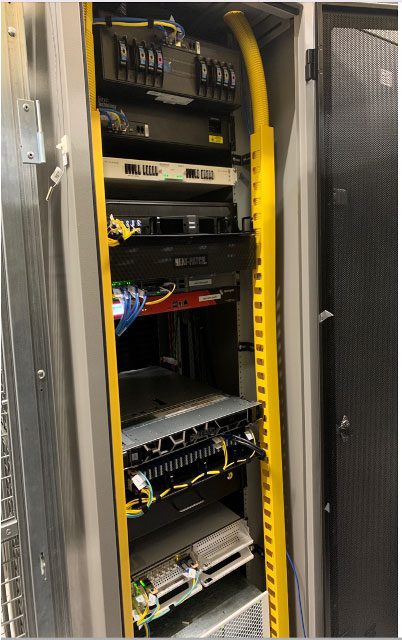By
Camille Davis-Alfs - Engineering Services Manager
Estimated reading time: 5 minutes
As Internet2 embarked on the Next Generation Infrastructure (NGI) project, conversations continued about how technology and innovation can enhance our lives and enable progress around the world – but often at an environmental cost.
Internet2’s network – and the space, power, and cooling capacity it requires – is part of our community’s carbon footprint. But could we do better? Could we seize the opportunity to build a greener future with a new network for the research and education (R&E) community?
So with the community’s support, striving for a greener infrastructure became a core goal for the NGI project, while also delivering new services, improving the network’s capabilities, and increasing its capacity. We set out to achieve three outcomes:
- Reduce total power consumed by the platform,
- Reduce space required to operate the platform, and
- Permit savings to flow into service enhancements.
Doing More With Less
Data colocation facilities are experiencing high demands, so one of Internet2’s strategies was to focus on right-sizing its colocation space and power for the NGI network. Combining the latest space- and power-saving optical and routing equipment with some design creativity, we aimed to keep equipment within a single rack in at least half of Internet2’s points of presence (POPs).
Initially, one of the toughest challenges was getting buy-in for the idea that it was even possible to run an advanced, high-capacity network with one rack of equipment using less than 30 amps of DC power.
 Many Internet2 NGI locations support optical, packet, and management equipment in one high-density cabinet with a power draw between 22-24 amps.
Many Internet2 NGI locations support optical, packet, and management equipment in one high-density cabinet with a power draw between 22-24 amps.
To accomplish this, we ordered high-density, deep cabinets. We also opted to install equipment starting at RU0, which is the bottommost rack unit that often goes unused, to make the most of the space available. We installed from the bottom up, starting with optical equipment and leveraging every single rack unit as we went up, with power at the top. For power, we used one primary/redundant power feed to supply all our power distribution units (PDUs) at a location, which are then daisy-chained together.
And the power savings followed. For example, we saw a reduction in power consumption of more than 7,000 watts at the Los Angeles POP, where we went from four racks to two, and nearly 4,200 watts at the Albany POP, where we went from two racks to one with room for expansion.
Internet2’s NGI has 46 POPs in total, 28 of which have one rack and on average consume approximately 1,050 watts or 22 amps. That’s well over half of our POPs that have met that one-rack benchmark using less than 30 amps of DC power. The remaining 18 require two racks and on average use approximately 3,360 watts or 70 amps.
So what’s the result? The Internet2 network’s total power consumption has dropped by 68% with NGI. This enables cost savings that can be reinvested back into the infrastructure and reduces Internet2’s carbon footprint.
By our calculations, that translates to a reduction of 1,215.67 metric tons of CO2 annually, according to the Environmental Protection Agency’s Greenhouse Gas Equivalencies Calculator.
According to that same calculator, this is equivalent to the amount of carbon sequestered by 1,450 acres of U.S. forests in one year or the amount of greenhouse gas emissions avoided by recycling 421 tons of waste instead of sending it to the landfill.
Tips to Strive for a Greener Network
If you’re an R&E network operator wondering if a greener infrastructure is an achievable goal for you, too, the answer is yes! Based on our experience and the lessons we learned, I can offer a few quick tips.
First, make data-informed decisions. Request actual hardware vendor power draw information, instead of estimates which tend to be much higher, to support right-sizing the power circuit. And get creative with your power design to be as efficient as possible! Do the same with rack space management, thinking about how each RU within a rack is valuable as we did by leveraging every available RU.
Finally, seize the opportunity to go greener when modernizing your network. Future networks can increase capacity with significant environmental savings – we’re talking huge amounts of capacity in high-performance routers that are only 1.75 inches tall! Vendor advances in hardware and software-driven networking make these efficiencies possible, with the caveat that some of the cutting-edge features aren’t built into the equipment on day one. So patience is required while vendor-provided software upgrades are developed. The availability of automation and orchestration capabilities with high-performance routers can streamline your operations for engineering staff, with ample benefits that outweigh those initially missing software features. Ultimately, these low-scale, high-performance platforms can offer recurring cost savings and power reductions in the long run, leading to a greener footprint.
ICYMI
About the Author(s)
Camille is a technical engineering manager with Internet2 Network Services. She has worked in the research and education (R&E) world since 1999. Her goal is to ensure high-quality engineering and support is provided to customers and internal team members.